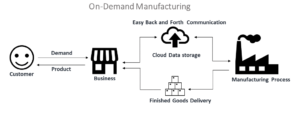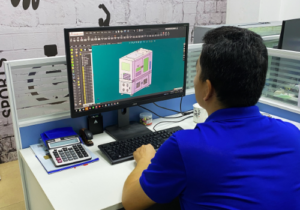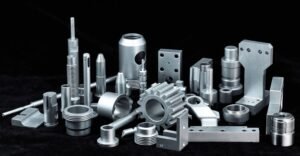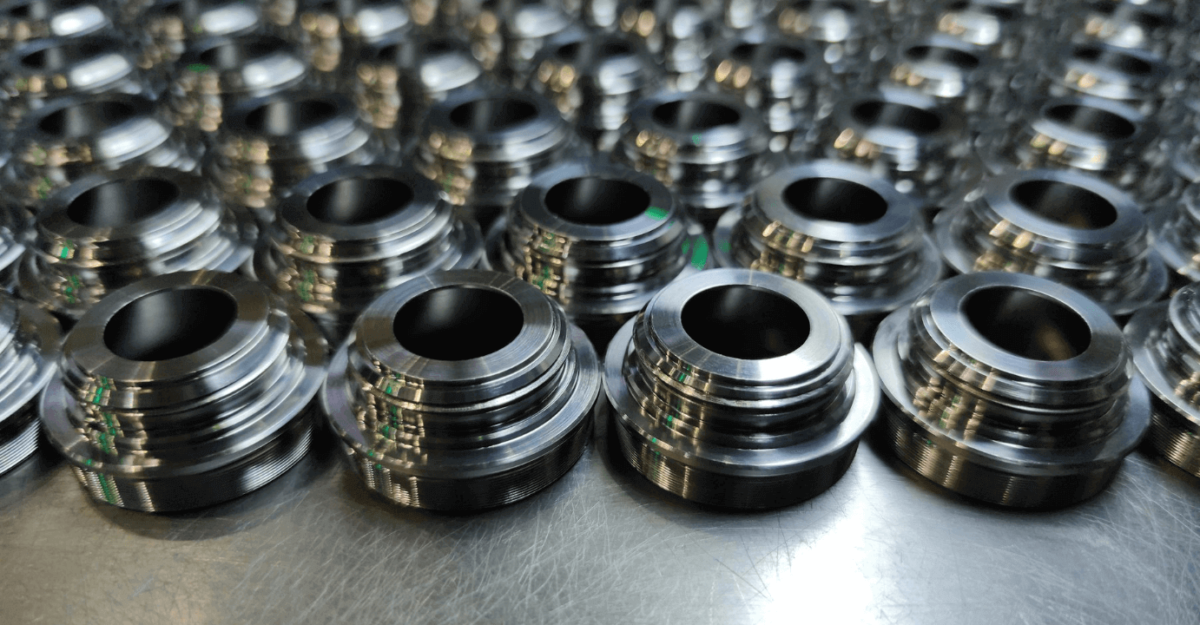Introduction
On-demand manufacturing is becoming increasingly popular in all manufacturing sectors. It offers myriads of opportunities for manufacturers to increase their profits.
What is it? How is it better than traditional methods? What made it possible? We have addressed all your questions and much more in this detailed guide.
So let us explore on-demand manufacturing and its applications.
What is On-Demand Manufacturing?
On-demand manufacturing is a revolutionized process of manufacturing products on customer demand. It is a custom manufacturing model and also called cloud manufacturing.
This model has made rapid shipment possible. Moreover, companies can now make rapid prototypes using the latest technologies.

What About the Traditional Manufacturing Process?
To better grasp the on-demand manufacturing concept, let us briefly discuss traditional manufacturing. Traditionally, manufacturing plants get orders from clients to manufacture products in bulk.
These orders are made by predicting the demand of customers for the specific product. It is then mass-produced and shipped to the client. Whether it is automotive, aerospace, or the textile industry, every business sector follows it.
This model brings a lot of problems, such as the wastage of excess products that fail to sell. It also wastes time and resources used to manufacture the bulk quantities.
Traditional manufacturing also does not favor small to medium-scale businesses that want a cost-effective approach to manufacture small orders.
How Does On-Demand Manufacturing Work?
With the advent of Computer Numeric Control (CNC) lathe, milling, turning, and advanced laser cutting machines, 3D machines, and the rise of cloud technologies, the shackles of heavy investments and machinery have shattered. This gave rise to the methodology of production on demand.
You might be skeptical about the cost-effectiveness of on-demand manufacturing. Some decades ago, this would be a foolish idea because it costs a lot more to produce a product in small numbers. The cost of labor, material, and machinery made it impossible. Add the skill level required for a specialized design; it was not practical.
This all changed when the world was introduced to CNC machining. The post-amazon world completely changed the economic dynamics and introduced e-commerce.
This gave small-scale businesses a chance to excel with their talents and ingenuity without needing costly setups and bulk pre-production orders.
The need for inventory has also reduced resulting in more profits for businesses.
Cloud technologies have revolutionized the ordering, payment, and delivery systems. Now orders can be placed within seconds, and effective communication is possible. This opens the world of real-time client input and customization of the product.

CNC Machining and 3D Printing
With on-demand manufacturing, a client can order products in small numbers and get customized products in a short time. The procedure eliminates the need for inventory.
Modern CNC lathe, milling, and advanced welding machines can produce a product with high precision and a short turnaround time (TAT).
These machines use computer-generated G and M codes to manufacture products. These codes are based on Computer-Aided Design (CAD) models.
3D printing uses the same approach by its manufacturing process, commonly known as additive manufacturing.
Sheet Metal Fabrication and On-Demand Manufacturing
Sheet metal is a crucial part of any product design. Examples range from household products to automobile parts and everything between.
The sheet metal fabrication process includes punching, welding, and bending. And post-processing treatments such as finishing and polishing.
Traditional manufacturing uses heavy machinery and large industrial setups to cover this huge demand. It lacks flexibility, real-time custom input from clients and invites struggles of maintaining inventory and enforcing MOQ.
However, CNC machining gave a way of addressing short and custom demands of clients with lighting fast and precise technology of numeric control. The powerful software and precise hardware can produce rapid products that were previously impossible with traditional milling and lathes.
It is safe to say that CNC machining has paved the way to the fascinating world of on-demand manufacturing.
Difference Between On-Demand Manufacturing and Traditional Manufacturing
Let’s understand the difference between on demand and traditional models.
What is Traditional Manufacturing?
In traditional manufacturing products are manufactured in bulk quantities and reserved in warehouses. They are then extracted from inventory as per the customer’s demands.
The Disadvantages Associated with Traditional Manufacturing
- Traditional production is suited for large businesses that produce bulk orders. The production equipment, in this case, is usually situated overseas.
- The whole process of production, testing, and delivery is stretched over a span of 8-12 months.
- Due to high MOQ, these industries end up producing larger quantities than required.
- The excess quantity needs to be disposed of or stored for next season which is a waste of energy, time and money. It negatively affects the business on many levels.
- On the other hand, under-production leads to supply shortages, shipment delays and heavy losses.
Check out the detailed comparison table below.
Traditional manufacturing principles | On-demand manufacturing principles | |
Markdowns | The over-production of items results in markdowns. Profits reduce when products are sold at discounted rates. Thus, it negatively affects the business | There is no need for markdown products as there is no excess production and leftover inventory |
Inventory Management | Companies following the traditional model require a large industry and inventory where products are manufactured and stored. This demands heavy investment and management costs. | On-demand production eliminates the need for inventory which cuts down a considerable cost. This budget is essentially used in making niche and specialized products. |
Production Methods | CNC machining, plastic molding, injection methods, plastic forming | On demand manufacturing companies can leverage all the techniques used in traditional companies in addition to additive manufacturing (3D print) |
MOQ | Businesses have to enforce MOQ to gain profits from orders. Small MOQ orders cannot be entertained | The process starts after the receipt of orders. This makes MOQ highly flexible in the on-demand manufacturing model |
Communication | Traditional business uses emails/calls for correspondence which delays the whole process. | All the information from every point in the supply chain is stored in a cloud system and is accessible within seconds. Customers can upload their specific demands and discuss their needs with the design team. The online system makes the production highly transparent. |
Fast Quotes | Traditional methods involve lengthy negotiations and correspondences over phone calls and emails. | Instant quotes and cost estimations are provided to clients through instant quote engines. |
Prototyping | Traditional businesses, in most cases, can not provide a prototype. Their management is built to cater to bulk production only. | Easy and quick prototyping is possible here. |
Lead time | All the delays in the process accumulate into long lead times. | Demand production offers incredibly short lead times. |
The Benefits of On-Demand Manufacturing
So, you may have got a pretty good idea of why on-demand manufacturing has been trending in recent years. Here we have listed some practical benefits of on-demand manufacturing for you to consider.
Cloud-Based Communication
Cloud is a data storage space on the internet that manufacturing companies can use to establish their online business. Nowadays, companies have centralized all their communication for on-demand manufacturing.
Clients can easily communicate and upload the required CAD files and drawings for the manufacturer. The manufacturer can quickly discuss the feasibility of the product and all the upfront cost.
With an online system, clients can choose local and international manufacturers according to their requirements. Talk about convenience!

Instant Prototype
Sometimes companies like to invest in developing a prototype of the product and test the market with it. Traditional manufacturing does not encourage this as the upfront cost for manufacturing lower quantities is too much.
But with the latest tools like CNC machines and 3D printing, on-demand manufacturing can develop prototypes in no time. You can use rapid prototyping to thoroughly test a product before launching it on a large scale.
On-demand manufacturing also encourages innovation in research industries. Driving the people into an era of exploration and design, limited to only their imagination.
Minimum Inventory and Less Wastage
With the lower production volumes and rapid delivery of the products, the need for insured inventory is reduced. With this cost reduction, the business can earn more profit and avoid delays.
Moreover, the production can never exceed the customer’s demand, and wastage is kept to a minimum. Efficient, profitable, and yet beneficial to the environment.
Almost $100 billion worth of textile materials is lost annually in traditional manufacturing. The waste forms a significant part of environmentally harmful waste. On demand manufacturing can significantly reduce landfill waste.
Quick Turn Around Time
Lower MOQ’s (minimum order quantities) and quick turnaround time makes on-demand manufacturing worthwhile.
Smooth Supply chain
With cloud technologies and online communication, the suppliers can be efficiently managed. This further smooths up the supply chain.
Inventory and storage areas are also reduced. The finished product ends up at your doorstep with the shortest lead time.
Cost-Effective Setup
CNC machines and 3D printers are compact and cost-effective. Their applications cover a vast area, and it may have a higher cost in initial setup, but long-term use proves to be beneficial.
With the popularity of on-demand manufacturing, there is no need for massive investment in setting up a production facility. On-demand manufacturing methodology opens the door to many new business opportunities.
It has become much easier to set up small-scale businesses with lesser initial capital.

Localized Production
The opportunity to regionalize production facilities cuts the lead time even further as you can establish the production facility close to your potential end-consumers. It essentially reduces shipping time and cost.
The flexible solutions help in more efficient production and supply of goods.
Potential to Scale up your business
Maybe you are planning to establish a side hustle or run a medium-size industry; on-demand manufacturing can pave the way for scaling your business. Produce the product in small orders and see how the market responds. Mass produce it if the reaction from customers is positive.
Many on-demand production startups have surfaced in recent years and have been successful in their profits.
Outsourcing Operations
Brands that like to focus more on designing can outsource their supply chain solutions. This leaves the company more time for introducing the newest marketing and selling strategies.
Moreover, companies can innovate, make more prototypes and introduce new items in the catalog.
Outsourcing operations is one of the opportunities on-demand manufacturing offers in scaling the business. Many on-demand manufacturers offer to handle inbound shipment and even designing the products.
On-Demand Manufacturing Examples
Amazon, the e-commerce giant, recently patented its on-demand manufacturing model. This shows how the world is shifting towards on-demand manufacturing.
· Fashion
The fashion industry is moving towards a more sustainable model and keeping the wastage of clothes to a minimum. In her recent interview, “Daniella Samper,”-Founder of “Ajai Alai”, a clothing brand, explored how on-demand manufacturing is the next big step in the fashion industry.
· Spare Parts
Many high-tech industries like Boeing, Rolls-Royce, McLaren invest resources in prototyping and designing efficient machines. They require rapid prototyping, and on-demand manufacturing is the way to go.
· Technology
On-demand manufacturing has triggered a new wave of tech startups. Recently many startups are offering digital inventories, AI-based online communications, workflow automation software, advancement in 3D printing, and enhanced CNC machining.
Downsides of On-Demand Manufacturing
There are a few downsides of on-demand manufacturing that you should consider.
A Small Margin for Error
On demand production depends on the exact number of orders. While this is a big advantage and saves money, the dependency on the seamless flow of supply chains tremendously increases.
Manufacturers rely on the production process, and any malfunction can cause indefinite delays.
These setbacks can be in the form of shortage of raw materials, machine malfunction, inflation on raw goods, etc.
On-demand model offers low inventory management. But any disruption can set back the whole production process.
We can prevent such setbacks by keeping a close eye on supply chains and implementing a high level of coordination.
Communication Problems
Although the cloud system offers seamless and thorough communication across the supply chains, customers and clients, there are certain instances where a lack of experience causes misunderstandings.
These instances include not clearly communicating the production timeline with the client, not passing on critical features or details of the products to the team, insufficient information about current manufacturing capacity.
The team must be trained to communicate efficiently and report every necessary detail on the cloud system.
Volume of Production
Companies that manufacture bulk quantities on a regular basis should opt for the traditional manufacturing style. On demand is best for prototyping, new product introduction (NPI) and manufacturing a small number of high-end products. Still, it may not be suitable for sustained manufacturing of huge orders.
Better understand your niche and industry first, to decide which production method will go best for your type of business.
Service Availability
The suppliers must be able to fill an unexpectedly high production demand. Companies ought to keep a check on service availability so they can cater to the needs of customers in a designated timeframe.
Managing Design Requirements
The company should have a designer in the team who can pass on the design requirements and any product specification changes to the on-demand manufacturers. If there is a miscalculation on the part of the company in providing the details of the product, it may lead to delays in production.
The on-demand suppliers will need to make changes repeatedly, affecting both budget and time constraints.
Intellectual Property Theft
The company forwards all the product details to the customer, and every specification is available online for clients to check and analyze. A breach in security can lead to substantial data losses. Adequate security protocols must be in place to avoid such disasters.
A company should save information of all the people involved in the project prior to revealing the important data.

How Can Company Choose Which Manufacturing Method to Invest in?
Choosing and investing in the right manufacturing process is crucial in starting the business. A few questions must be kept in mind to help make the decision easier.
- How large is the production scale? Large-scale production is best accomplished using traditional injection molding, forming, and CNC machining methods. On the contrary, on-demand manufacturing models are best for small scale businesses.
- What are the product design and material? Products requiring higher dimensional accuracy and finishing must be manufactured using advanced CNC machining and 3D printing technologies. Analyze the complexity of your item. For precise finishing, you can consider introducing laser technologies as well.
- How quickly would you need your items to be produced? The traditional model requires renewing of the tools and dies. Factory is ramped up according to the product demand. This takes up to a week for the first item to be manufactured. On the other hand, additive technology can complete the prototype and quick small orders in a matter of days.
Final Thoughts
On demand manufacturing enables the customers to customize their orders. It gives them an opportunity to bring their ideas into reality.
Using this model, businesses can give special attention to designing and innovating items.
Manufacturers want higher efficiency in their production. On demand model helps by introducing virtual prototyping and better product lifecycle management.
On demand manufacturing incorporates all their needs into one model, leading to a smarter future.
This model is helps in the current times of COVID 19, when the need for smaller inventory and limited storage, and shortened supply chain is high.
Conclusion
QBH has successfully fulfilled the prototyping, low-volume manufacturing services and product testing of thousands of business owners so far.
Our expertise in advanced CNC machining and sheet metal fabrication has helped us establish a solid reputation in this industry.
The decade of experience in manufacturing has given us sound knowledge in the machining of many materials, including aluminum, brass and stainless steel.
We will manufacture your product with superb accuracy within days. Contact our customer support team and connect with the professional team of designers and engineers ready to help you.

